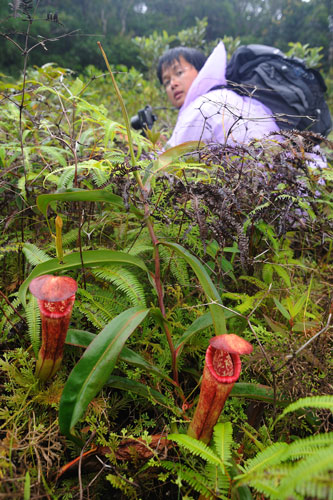Exploring for rare plants (including insectivorous ones) in IndoChina, and the challenges of the politics
Thanks to all those people who attended this webcast live April 23rd. Here is the recorded video of François Mey's presentation in case you missed it. The corresponding Power Point is also available in a PDF format below.
View PDF of  "Exploring for rare plants in IndoChina, and the challenges of the politics" (Large File 174 MB)
"Exploring for rare plants in IndoChina, and the challenges of the politics" (Large File 174 MB)
Please also visit François Mey's blog http://carnivorousockhom.blogspot.com/ for more information.
Author
François Mey was born in Ha-Tien, Vietnam, after his Cambodian parents fled the Khmer Rouge regime. He arrived in France at the age of three, and now teaches French literature in high school. He became seriously interested in carnivorous plants in 2004, and has since intensively studied their systematics and ecology, with a particular focus on the Indochinese Nepenthaceae. François has undertaken extensive field research across Cambodia and Vietnam, and his observations led to the publications of N. bokorensis and N. holdenii. He produced several botanical diagrams and illustrations for a number of carnivorous plant books and is now, with biologist Jeremy Holden, currently working on a book devoted to the carnivorous plants of Cambodia.
Resume
As a result of past internal and international conflicts, Cambodian borders have long been closed to researchers. It was only in the late 1990s that scientists were able to begin investigating Cambodia's biological diversity in earnest. Thanks to the increased efforts of local and international scientists, Cambodia is now revealing its diverse flora and fauna. Even so, the documentation of biodiversity in Cambodia is still in its infancy and, without doubt, many species remain undescribed. Data on the flora of Cambodia, are particularly scant. The number of plant collections has risen steadily in the past decade, but owing to a lack of research and literature, hundreds of specimens remain unidentified.
Cambodia is the home to several species of carnivorous plants. These attract, capture, kill and digest prey, using modified leaves which act as traps. This group of plants, which is currently composed of approximately 720 species divided among 11 families and 19 genera, is represented in Cambodia by three genera in three different families: the sundews Drosera L. (Droseraceae), the pitcher plants Nepenthes L. (Nepenthaceae) and the bladderworts Utricularia L. (Lentibulariaceae). Carnivorous plants from countries of the Indochinese Peninsula, namely Cambodia, Laos, Thailand and Vietnam, have received little attention from researchers in contrast with those from other parts of the world, such as Australia, the Malesian region, South Africa and the Americas, where many species have been studied and described. The literature on Cambodian carnivorous plants, in particular, is scarce and has not been updated in recent years. The majority of records date back to colonial times, from the end of the 19 th century to the early 20 th century. Although the spectacular genus Nepenthes has been the subject of several recent papers, only a relatively small part of Cambodian territory has been explored for these plants. As a result, significantly more surveillance work is needed to develop a full understanding of the diversity and the distribution of Nepenthes in Cambodia. In the same fashion, though to a greater extent, the relatively inconspicuous carnivorous plant genera Drosera and Utricularia clearly require further in depth study. Most of the Cambodian carnivorous plants are adapted to the strongly seasonal Indochinese climate which is roughly divided into wet and dry seasons. Indochinese countries are subject to the influence of monsoons with seasonal rainfall patterns. The dry season begins in November or December and lasts until April or May. While most carnivorous plants worldwide occur in relatively wet habitats, species of the Indochinese Peninsula have adapted to conditions of seasonal drought. Four of the five Cambodian species of Nepenthes are regarded as pyrophytes. They have the ability to survive in seasonally dry savannahs or semi-deciduous monsoon forests, prone to dry season fires, by the development of water storage organs in the form of a fleshy rootstock. The carnivorous plants of the two other genera have developed their own ways to survive the Indochinese climate. One of the Drosera species, Drosera peltata Thunb., produces a tuber, typical of the tuberous Drosera species within the section Ergaleium. The tuber allows the plant to survive the dry season in a dormant state. The other two Cambodian Drosera species, D. indica L. and D. burmanni Vahl, are annual species that endure the drought as seeds. Several of the Utricularia species, including U. caerulea L. and U. bifida L., are also annual species.
The genus Nepenthes currently includes 130 species worldwide, with the islands of Borneo and Sumatra, as well as the southern Philippine archipelago, considered to be the Nepenthes centers of diversity. They host 36, 37 and 25 species respectively. In comparison, only five species are known from Cambodia and 14 from the four countries of the Indochinese peninsula. Of these, nine species are thought to be so closely related that they have been ascribed to a single group, the Nepenthes thorelii aggregate.





